
Systema Naturae is one of the major works of the Swedish botanist, zoologist and physician Carl Linnaeus (1707–1778) and introduced the Linnaean taxonomy. Although the system, now known as binomial nomenclature, was partially developed by the Bauhin brothers, Gaspard and Johann, Linnaeus was first to use it consistently throughout his book. The first edition was published in 1735. The full title of the 10th edition (1758), which was the most important one, was Systema naturæ per regna tria naturæ, secundum classes, ordines, genera, species, cum characteribus, differentiis, synonymis, locis or translated: "System of nature through the three kingdoms of nature, according to classes, orders, genera and species, with characters, differences, synonyms, places".

The common dab is an edible flatfish of the family Pleuronectidae. It is a demersal fish native to shallow seas around Northern Europe, in particular the North Sea, where it lives on sandy bottoms down to depths of about 100 metres (330 ft). It can reach 40 centimetres (16 in) in length and can weigh up to 1 kilogram (2.2 lb), though most specimens grow no longer than 20 centimetres (7.9 in).

The genus Paradisaea consists of six species of birds-of-paradise. The genus is found on the island of New Guinea as well as the nearby islands groups of the Aru Islands, D'Entrecasteaux Islands and Raja Ampat Islands. The species inhabit a range of forest types from sea level to mid-montane forests. Several species have highly restricted distributions, and all species have disjunct distributions. A 2009 study examining the mitochondrial DNA of the family found that the Paradisaea birds-of-paradise were in a clade with the genus Cicinnurus. It showed that the blue bird-of-paradise was a sister taxon to all the other species in this genus.
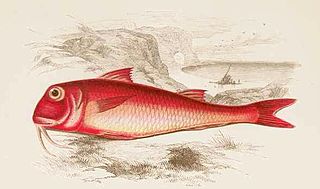
Mullus is a subtropical marine genus of perciform fish of the family Mullidae (goatfish) and includes the red mullets, occurring mainly in the southwest Atlantic near the South American coast and in the Eastern Atlantic including the Mediterranean and the Black Sea. These fish are benthic and can be found resting and feeding over soft substrates.

The common cockle is a species of edible saltwater clam, a marine bivalve mollusc in the family Cardiidae, the cockles. It is found in waters off Europe, from Iceland in the north, south into waters off western Africa as far south as Senegal. The ribbed oval shells can reach 6 centimetres (2.4 in) across and are white, yellowish or brown in colour. The common cockle is harvested commercially and eaten in much of its range.
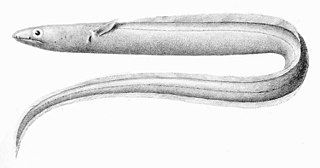
Echelus is a genus of eels in the snake-eel family Ophichthidae.

Gnathophis mystax, the thinlip conger or blacktailed conger, is an eel in the family Congridae. It was described by François Étienne Delaroche in 1809, originally under the genus Muraena. It is a subtropical, marine eel which is known from the eastern Atlantic Ocean, including southern Portugal, the Mediterranean, and Morocco. It dwells at a depth range of 75–800 metres, and inhabits mud and sand on the continental slope. Males can reach a maximum total length of 60 centimetres, but more commonly reach a TL of 35 centimetres.
The Indian pike conger is an eel in the family Muraenesocidae. It was described by Pieter Bleeker in 1853. It is a marine, tropical eel which is known from the Indo-Western Pacific, including Somalia, India, Sri Lanka, Indonesia, the Philippines, Hong Kong and Taiwan. It dwells at a depth range of 800 to 875 metres, and inhabits soft sediments in coastal waters and estuaries. Males can reach a maximum total length of 250 centimetres (98 in), but more commonly reach a TL of 180 centimetres (71 in).
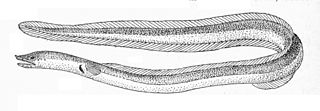
The ordinary snake eel is an eel in the family Ophichthidae. It was described by Pieter Bleeker in 1864, originally under the genus Echelus. It is a marine, tropical eel which is known from the Indo-Western Pacific, including Vietnam, Japan, Fiji, the Marshall Islands, and Australia. It inhabits sandy sediments. Males can reach a maximum total length of 39 centimetres.
Callechelys catostoma, the black-striped snake eel or dark band snake eel,) is an eel in the family Ophichthidae. It was described by Johann Gottlob Theaenus Schneider and Johann Reinhold Forster in 1801. It is a tropical, marine eel which is known from the Indo-Pacific, including the Red Sea, East Africa, the Society Islands, the Ryukyu Islands, and Lord Howe Island. It dwells at a depth range of 1–32 metres, and inhabits reefs. It burrows into loose gravel and sand. Males can reach a maximum total length of 85 centimetres.
Callechelys guineensis, the shorttail snake eel, is an eel in the family Ophichthidae. It was described by Balthazar Osório in 1893, originally under the genus Ophichthys. It is a marine, tropical eel which is known from the western and eastern Atlantic Ocean, including Florida, USA, Puerto Rico, Venezuela, the Bahamas, Saint Barthélemy, Senegal, Lesser Antilles, and Cape Verde. It dwells at a depth range of 4 to 35 metres, and inhabits the continental shelf, where it forms burrows in sand and mud. Males can reach a maximum total length of 108 centimetres (43 in).
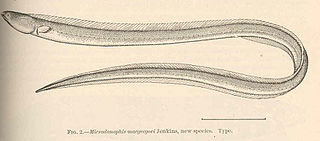
The fringelip snake-eel is an eel in the family Ophichthidae. It was described by Albert Günther in 1870. It is a marine, tropical eel which is known from the Indo-Pacific, including Zanzibar, Tanzania, Kosi Bay, South Africa, and the Hawaiian Islands. Its lifestyle is mostly benthic but it sometimes swims at the surface. It is olive brown in colour, with lighter colouring in the ventral region. Males can reach a maximum total length of 39 centimetres (15 in).
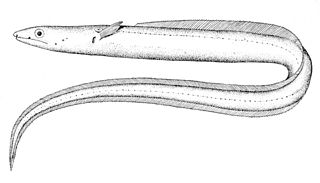
Echelus pachyrhynchus is an eel in the family Ophichthidae. It was described by Léon Vaillant in 1888. It is a marine, deep water-dwelling eel which is known from the eastern Atlantic Ocean, including Morocco, Angola, Cape Verde, and Namibia. It dwells at a depth range of 200–500 metres, and inhabits burrows in mud or sand on the continental shelf. Males can reach a maximum total length of 48.5 centimetres.
The Finned worm eel is an eel in the family Ophichthidae. It was described by Coenraad Jacob Temminck and Hermann Schlegel in 1846. It is a marine, tropical eel which is known from the Indo-Pacific, including East Africa, the Society Islands, and southern Japan. It is known to dwell in reefs. It is the only worm eel in its region which possesses pectoral fins. Males can reach a maximum total length of 60 centimetres.
Ophichthus ophis, the spotted snake eel, is an eel in the family Ophichthidae. It was described by Carl Linnaeus in 1758, originally under the genus Muraena. It is a marine, subtropical eel which is known from the western and eastern Atlantic Ocean, including Bermuda and southern Florida, USA, Brazil, Lesser Antilles, Senegal, Angola, and the Mediterranean. It dwells at a depth range of 21 to 50 metres, usually at around 50 m, and lives in burrows on a permanent basis. Males can reach a maximum total length of 210 centimeters (83 in), but more commonly reach a TL of 100 centimeters (39 in).
The rufus snake eel is an eel in the family Ophichthidae. It was described by Constantine Samuel Rafinesque in 1810, originally under the genus Echelus. It is a marine, subtropical eel which is known from throughout the Mediterranean and the Black Sea, in the northeastern Atlantic Ocean, including Algeria, Albania, Croatia, Egypt, France, Cyprus, Gibraltar, Greece, Italy, Israel, Montenegro, Lebanon, Libya, Malta, Morocco, Monaco, Slovenia, Spain, Tunisia, the Syrian Arab Republic, and Turkey. It inhabits mud sediments on the continental shelf. Males can reach a maximum total length of 60 centimetres (24 in).

The rice-paddy eel is an eel in the family Ophichthidae. It was described by Francis Buchanan-Hamilton in 1822, originally in the genus Ophisurus. It is a tropical, marine eel which is known from the Indo-West Pacific, including Somalia, Tanzania, South Africa, southern India, Sri Lanka, Indonesia, Polynesia, Australia, Bangladesh, Cambodia, Kenya, Madagascar, the Philippines, Malaysia, Mozambique, Seychelles, Saudi Arabia, Taiwan, China, Thailand, Vietnam, and southern Yemen. It is an anadromous species and spawns in freshwater, often in rice paddies during the rainy season, earning it its common name. It also spends time in lagoons, estuaries and coastal rivers, in which it lives in burrows in the river bottom and bank. Males can reach a maximum total length (TL) of 100 centimetres, but more commonly reach a TL of 70 cm.
The short-tooth sawpalate is an eel in the family Serrivomeridae. It was described by Johannes Schmidt in 1916, originally under the genus Leptocephalus. It is a marine, deep water-dwelling eel which is known from the eastern central and western central Atlantic Ocean, including the Bahamas and Bermuda, as well as the Strait of Gibraltar, Cape Verde, Canada and the United States. It dwells at a depth range of 150 to 1,000 metres. Males can reach a maximum total length of 65 centimetres (26 in).

The coco sea catfish is a species of sea catfish in the family Ariidae. It was described by Carl Linnaeus in 1776, originally under the genus Silurus. It inhabits tropical marine and brackish waters ranging between Colombia and the Amazon River, in South America. It dwells at a maximum depth of 50 m (160 ft). It reaches a maximum total length of 55 cm (22 in), more commonly reaching 40 cm (16 in).

Acanthocardia echinata, the prickly cockle or European prickly cockle, is a species of saltwater clam, marine bivalve molluscs in the family Cardiidae. The genus Acanthocardia is present from the Upper Oligocene to the Recent.












